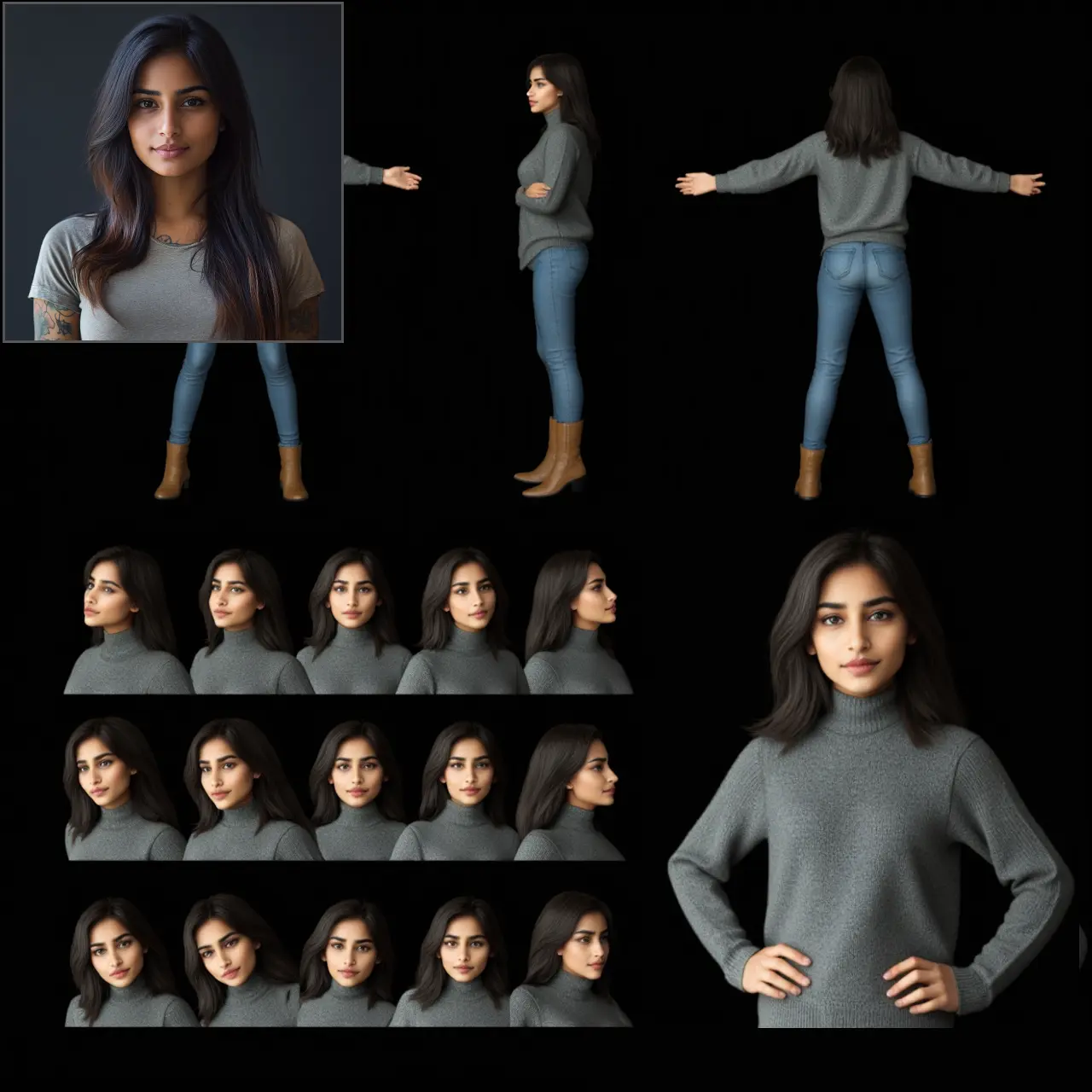ComfyUI Node: Human4D Image2SMPL
Human4D_Img2SMPL
CategoryMotionDiff
Fannovel16 (Account age: 3416days) Extension
ComfyUI MotionDiff Latest Updated
2024-08-01 Github Stars
0.2K
How to Install ComfyUI MotionDiff
Install this extension via the ComfyUI Manager by searching for ComfyUI MotionDiff- 1. Click the Manager button in the main menu
- 2. Select Custom Nodes Manager button
- 3. Enter ComfyUI MotionDiff in the search bar
Visit ComfyUI Online for ready-to-use ComfyUI environment
- Free trial available
- 16GB VRAM to 80GB VRAM GPU machines
- 400+ preloaded models/nodes
- Freedom to upload custom models/nodes
- 200+ ready-to-run workflows
- 100% private workspace with up to 200GB storage
- Dedicated Support
Human4D Image2SMPL Description
Convert 2D images to 3D SMPL models for realistic AI-generated human figures.
Human4D Image2SMPL:
The Human4D_Img2SMPL node is designed to convert 2D images into 3D SMPL (Skinned Multi-Person Linear) models, enabling the transformation of human figures detected in images into detailed 3D representations. This node leverages advanced human detection and pose estimation techniques to accurately capture the 3D structure and keypoints of individuals in the input images. By utilizing this node, you can seamlessly integrate 3D human models into your projects, enhancing the realism and interactivity of your AI-generated art. The primary goal of this node is to facilitate the creation of high-fidelity 3D human models from 2D images, making it an invaluable tool for AI artists looking to add depth and dimension to their work.
Human4D Image2SMPL Input Parameters:
human4d_model
This parameter represents the pre-trained Human4D model that will be used for detecting and processing human figures in the input images. It is essential for the node's operation as it contains the necessary configurations and weights for accurate human detection and pose estimation. The model should be loaded and configured correctly to ensure optimal performance.
image
The image parameter is the input image or a batch of images that you want to process. This image will be analyzed by the Human4D model to detect human figures and estimate their 3D poses. The image should be in a format compatible with the model, typically a tensor with pixel values scaled appropriately.
det_confidence_thresh
This parameter sets the confidence threshold for the human detection process. It determines the minimum confidence level required for a detected human figure to be considered valid. A higher threshold will result in fewer detections but with higher confidence, while a lower threshold will increase the number of detections, potentially including less confident ones. The default value is typically set to balance accuracy and detection rate.
det_iou_thresh
The Intersection over Union (IoU) threshold for non-maximum suppression during human detection. This parameter helps in filtering out overlapping bounding boxes, ensuring that only the most relevant detections are retained. A higher IoU threshold will result in fewer overlapping detections, while a lower threshold may allow more overlaps. The default value is chosen to optimize detection performance.
det_batch_size
This parameter specifies the batch size for the human detection process. It determines the number of images processed simultaneously during detection. A larger batch size can speed up the detection process but requires more memory, while a smaller batch size is more memory-efficient but may be slower. The default value is set to balance performance and resource usage.
hmr_batch_size
The batch size for the Human Mesh Recovery (HMR) process, which estimates the 3D poses of detected human figures. Similar to the detection batch size, a larger HMR batch size can improve processing speed but requires more memory, while a smaller batch size is more memory-efficient but may be slower. The default value is chosen to optimize the HMR process.
opt_scorehmr_refiner
An optional parameter for refining the HMR scores. If provided, it enables additional refinement of the estimated 3D poses to improve accuracy. However, this feature is not yet implemented, and attempting to use it will raise a NotImplementedError.
Human4D Image2SMPL Output Parameters:
verts_frames
This output parameter is a list of vertices for each detected human figure in the input images. Each element in the list represents the 3D coordinates of the vertices for a single frame, providing a detailed 3D mesh of the human figure. This data is crucial for rendering and further processing of the 3D models.
kps_2d_frames
A list of 2D keypoints for each detected human figure in the input images. Each element in the list contains the 2D coordinates and confidence scores of keypoints for a single frame. These keypoints are essential for understanding the pose and alignment of the human figures in the 2D space.
cam_t_frames
This output parameter provides the camera translation parameters for each frame, which are necessary for accurately positioning the 3D models in the scene. These parameters help in aligning the 3D models with the original 2D images, ensuring a coherent and realistic representation.
faces
The faces parameter contains the face indices of the 3D mesh, defining how the vertices are connected to form the surface of the 3D model. This information is essential for rendering the 3D models and ensuring that the mesh is correctly constructed.
Human4D Image2SMPL Usage Tips:
- Ensure that the input images are pre-processed and scaled appropriately to match the expected input format of the Human4D model.
- Adjust the
det_confidence_threshanddet_iou_threshparameters to fine-tune the detection process based on the complexity and quality of your input images. - Use a batch size that balances processing speed and memory usage, especially when working with large datasets or high-resolution images.
- Verify that the Human4D model is correctly loaded and configured before running the node to avoid errors and ensure optimal performance.
Human4D Image2SMPL Common Errors and Solutions:
NotImplementedError: opt_scorehmr_refiner is not implemented
- Explanation: This error occurs when the
opt_scorehmr_refinerparameter is provided, but the feature is not yet implemented in the node. - Solution: Avoid using the
opt_scorehmr_refinerparameter until the feature is implemented. Remove this parameter from your configuration to proceed without errors.
RuntimeError: CUDA out of memory
- Explanation: This error indicates that the GPU memory is insufficient to process the input images with the specified batch size.
- Solution: Reduce the
det_batch_sizeandhmr_batch_sizeparameters to lower memory usage. Alternatively, consider using a machine with more GPU memory.
ValueError: Invalid image format
- Explanation: This error occurs when the input image is not in the expected format or has incorrect pixel values.
- Solution: Ensure that the input image is correctly pre-processed and scaled to match the expected format. Convert the image to a tensor with appropriate pixel values before passing it to the node.
KeyError: Missing model configuration
- Explanation: This error indicates that the Human4D model configuration is missing or not correctly loaded.
- Solution: Verify that the Human4D model and its configuration are correctly loaded and available. Ensure that the model paths and URLs are correctly specified and accessible.
Human4D Image2SMPL Related Nodes
RunComfy is the premier ComfyUI platform, offering ComfyUI online environment and services, along with ComfyUI workflows featuring stunning visuals. RunComfy also provides AI Models, enabling artists to harness the latest AI tools to create incredible art.


